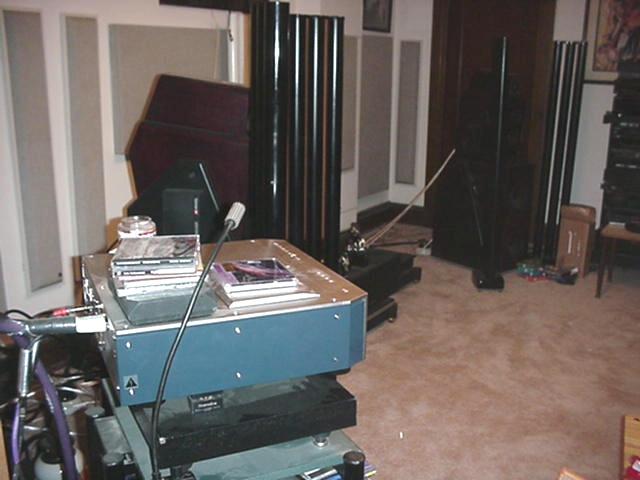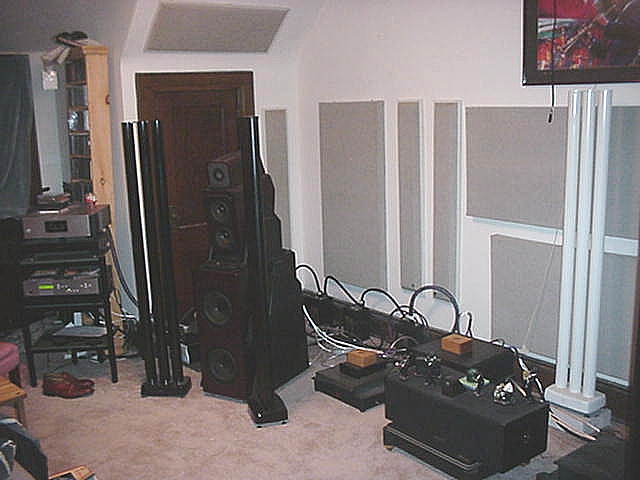Event – A First Trip to Clement’s
| Event – A First Trip to Clement’s |
| Henry Wilkenson |
| 30 March 2000 |
 I believe that it is always a good idea to listen to live un-amplified music whenever possible and reference quality sound systems. By doing this, one will not only keep their aural frame of reference from stagnating, but keep as a fresh reminder the sound of real instruments. The first system of this nature that I listened to was at a dealer’s showroom. The system included Quad loudspeakers, a Goldmund turntable, and Mark Levinson amps. Before that, I had never heard anything like that kind of clarity and dimensionally from any other audio system. The tonal quality of the instruments reproduced on that system was remarkable.
I believe that it is always a good idea to listen to live un-amplified music whenever possible and reference quality sound systems. By doing this, one will not only keep their aural frame of reference from stagnating, but keep as a fresh reminder the sound of real instruments. The first system of this nature that I listened to was at a dealer’s showroom. The system included Quad loudspeakers, a Goldmund turntable, and Mark Levinson amps. Before that, I had never heard anything like that kind of clarity and dimensionally from any other audio system. The tonal quality of the instruments reproduced on that system was remarkable.
The next high-end system that I consider as reference caliber belongs to my friend Jimmy Marks. His system consists of Magnapaners, a Cary tube preamplifier, separate transport, and tube DAC. The power amps are modified Dyna Mark ll’s. This is connected with Audio Insurgents interconnects and speaker cable.
Jimmy’s system consistently provides that oft referred to palpable presence and three-dimensional soundstaging whenever it is present in the recording. The tonality is accurate without being in any way cold or hard, no transisteritis here. Here the usage of tubes come into play and I also think that the Cary preamp’s under rated in this system, that preamp is excellent. Another advantage of tubes is that you can change the tubes and realize a corresponding change in the sound.
My system consists of older components but there is a synergy that allows it to render very good sound. My system is made up of the following: Thiel 1.0 speakers, Audible Illusions Modulus 2D pre-amp with Mullard NOS tubes, The Source Components Harmonic Recovery System, a modified B&K ST 140 power amp, AMC CD 6 compact disk player, VPI turntable with a Grado Arm and cartridge, Audio Prisim foundation 3 power line filter and isobearing isolation devices, Audio Insurgents Mystery interconnects and 5Beta Square speaker cable. At $139.00 a meter pair for the interconnects and $189.00 for a eight foot pair, given its performance, this wire is a real bargain. There may be better to be had out there but at no where near this price. I know, I know, an upgrade of my components is long overdue but I am slowly beginning to undertake that task.
Given that the system is used in a in a small, multipurpose, sonically difficult room, a new system must be put together with care in order to realize a good sonic result. Although this is true in any case, with a room such as mine, it presents a particular challenge.
Dewey (Heru) Wesley, a StereoTimes contributing writer, first told me about the internet based magazine StereoTimes and its publisher Clement Perry audio system. Both Dewey and I agreed that we needed to go and have a listen as soon as it could be arranged, if ever, since Clement (who likes to be called Perry) just moved into a huge beautiful home and hasn’t burned in his listening room yet. Ever heard of burning in a room? We’ll he did offer us a date. So off, we went to Clement’s, oops, I mean Perry’s house on a cold Saturday afternoon in February.
 The first thing I noticed is that listening room, apart from being on the third floor of his home, was of a pretty good size and very well damped with Echo Busters and other sound treatment devices. I thought that the shape of the room would tend to make it somewhat difficult sonically. Wrong! I had heard of the Von Schweikert loudspeakers many times in the past as well as the Sunfire signature power amp. One of the most intriguing pieces of the system was, of course, the Sony SCD-1, SACD player. This was my first time hearing any of these components individually or as a system.
The first thing I noticed is that listening room, apart from being on the third floor of his home, was of a pretty good size and very well damped with Echo Busters and other sound treatment devices. I thought that the shape of the room would tend to make it somewhat difficult sonically. Wrong! I had heard of the Von Schweikert loudspeakers many times in the past as well as the Sunfire signature power amp. One of the most intriguing pieces of the system was, of course, the Sony SCD-1, SACD player. This was my first time hearing any of these components individually or as a system.
The Sound
As many of you who are familiar with StereoTimes already know, Perry enjoys listening at truly realistic or “jazz club” levels. Given the overall sound quality of this system, this isn’t really a problem. I have heard other systems change their sonic character drastically as the volume was turned up but not for the better. In this case, the room seems to fill with sound with nothing beaming at you or becoming harsh. Having the room very well damped is an important factor in this case.
Before any music was cued up, I noticed the extremely quiet background of the system. There was an absence of any sounds that would indicate that the system was powered up. In addition to the quality if the components being used, I think the extensive power line filtering that is being employed here is contributing very heavily here. There just seemed to be a total absence of a noise floor. The music just came out of totally silent background. There was an exceptional clarity to the sound with very good detail without anything being in any way etched or over done. This is not a cold or clinical sound just a lack of any haze or grain. These are the kind of artifacts that you only recognize after they have been removed. I also felt there to be smoothness as well as effortlessness to whatever kind of music was playing.
A good example of what I am talking about became known while listening to the Shirley Horn CD, “You Won’t Forget Me.” This is a live recording with Ms. Horn sitting at the piano and, what appears to be, close to the microphone. This is the first time that I could actually hear the sound of her mouth opening when she drew her breath. You can ask is this kind of detail really musically important (?)
The answer would be no but the revealing nature of this system allows you to hear all of the musical nuance of the performance which in my humble opinion, is very important. What’s remarkable is to hear new details revealed on a recording that you are so familiar with for the first time. These kinds of experiences also tend to push your “I need to upgrade” button-thanks Perry.
We compared the SACD and the gold re-issue CD of Miles Davis “Kind of Blue” to get a sense of the advantages of SACD over the standard format. Although the differences were quite apparent, we still compared the Sony gold 20 bit SBM version against new Columbia House (Blue Seal) SACD version played back on the SCD-1 player. In this case, the SACD version was smoother and somewhat more dimensional and rounded, very much like analog. This is however, in comparison to the 20 bit gold disk that sounded very good on this machine to begin with. At some point, I would like to compare the 16-bit aluminum disk on a regular CD player to the SACD playing a SACD disk (Hint, hint, Perry).
All in all these are my observations after an all too brief (another hint Perry) first listen to this super high-end system. Certainly, some of the most memorable characteristics of Perry’s system was first its dynamics, imaging, detail, and top to bottom coherence. On lesser systems, (mine included) many of the dynamic contrasts in the music are glossed over. Again, this would be one of the things that you tend not to notice until you hear them.
On Keith Jarrrett “Live at the Village Vanguard“, you can clearly hear the dynamic shadings that are used to emphasize certain passages. This CD as with other live recordings allow a system to demonstrate the depth of the soundstage and spacing of the instruments. You will readily understand what is meant by “having air around instruments” and “everyone being in their own space”. This will allow you to get much closer to that “you are there quality”, one often hears about. Be aware that once you become accustomed to hearing these qualities, you tend not to want to be without them. Hence, the beginning of the upgrade syndrome that never really ends.
While attending a live performance, imaging never is an issue simply because you can see the performers on stage. At home, the localization of musicians on stage contributes to the illusion of reality. To paraphrase J Gordon Holt in a recent article he said that he “Wanted to know why the musicians were on stage rather than where they were on stage” He makes a very good point but I think that these two ends are not mutually exclusive and can be achieved with the right system. Detail; as it serves the musical performance is a good thing. It is one aspect that will get you closer to what the musicians intended. Once it becomes simply an end in and of itself in my opinion, the point of all of this is being missed.
The overall coherence of the system is what will allow you to forget that you are listening to a system in general and a loudspeaker in particular. I was surprised at how well the Von Schweikert speakers did their disappearing act.
This ability is one of the strong points of planar and perhaps to a lesser extent the electrostatic designs. One seldom finds this quality in a multi driver dynamic box speaker.
All of these elements should come together to involve you in the music. This is just what happens with Clement’s system. I want a system that compels you to listen to the music and forget about the equipment. One indication of how well this is happening is the length of your listening sessions. I have heard systems that after an hour and two Excedrin, it was time to leave. On the other had when a system is good, the hours pass by un- noticed during listening sessions. Hopefully, I will get to hear other hi-end systems with different configurations that represent different sonic points of view while pursuing my own upgrades.
![]()
Don’t forget to bookmark us! (CTRL-D)
Stereo Times Masthead
Publisher/Founder
Clement Perry
Editor
Dave Thomas
Senior Editors
Frank Alles, Mike Girardi, Russell Lichter, Terry London, Moreno Mitchell, Paul Szabady, Bill Wells, Mike Wright, and Stephen Yan,
Current Contributors
David Abramson, Tim Barrall, Dave Allison, Ron Cook, Lewis Dardick, John Hoffman, Dan Secula, Don Shaulis, Greg Simmons, Eric Teh, Greg Voth, Richard Willie, Ed Van Winkle, Rob Dockery, Richard Doran, and Daveed Turek
Site Management Clement Perry
Ad Designer: Martin Perry





Be the first to comment on: Event – A First Trip to Clement’s